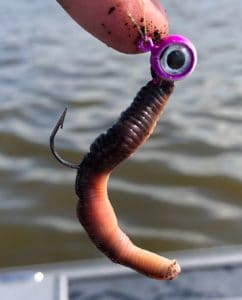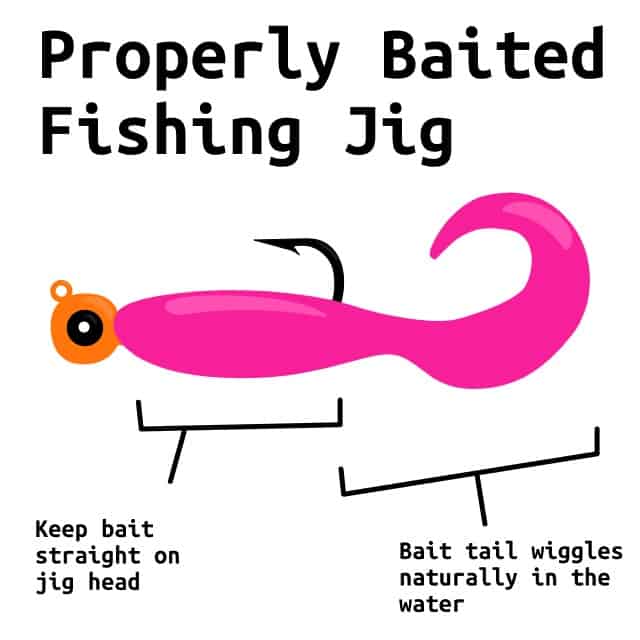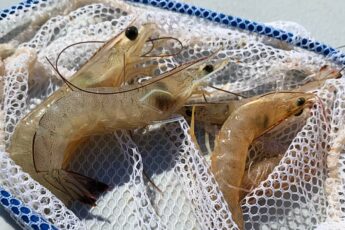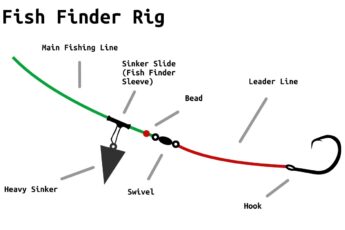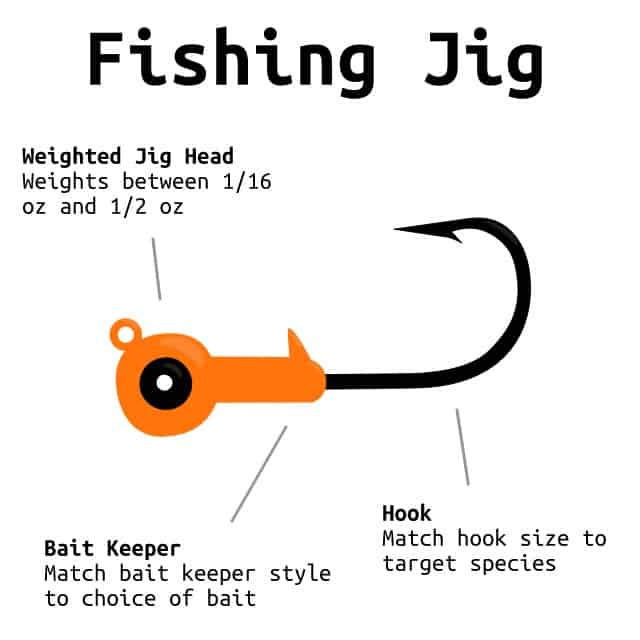
Versatile, simple, and effective…what’s not to like about jig fishing? Fishing jigs can catch anything from walleyes, to a lunker bass, to panfish. If you want to consistently catch fish, you need to know the ins and outs of how to jig fish. This article covers:
- What is Jig Fishing?
- How to Jig Fish?
- When to use a Fishing Jig?
- Best Jig Fishing Tackle and Equipment
- Jig Fishing Frequently Asked Questions
*Disclosure: I only recommend products I would use myself and all opinions expressed here are my own. This post may contain affiliate links that at no additional cost to you, I may earn a small commission.
What is Jig Fishing?
Jig fishing is a versatile fishing technique that uses a weighted hook with either live or artificial bait. Jig fishing techniques vary significantly and can range from covering water to find fish to vertical presentation with live bait over your favorite fishing honey-hole.
What is a Fishing Jig?
Fishing jigs consist of a lead sinker molded on a hook. The weighted jig head brings the jig to the target water depth and the jig hook can hold either live or artificial baits.

Fishing Jig components include:
- A weighted jig head. Variable colors. Weights are usually between 1/16 oz and 1/2 oz.
- A hook. Hook size should be matched to the size of your bait and the target fish species.
- A bait holder. Helpful for keeping your bait properly presented on your jig. Match the bait holder style to the type of bait you are using.
What Kind of Fish Can You Catch Jig Fishing?
Most game fish species can be targeted by jig fishing with the correct type of jig and bait.
Common freshwater species targeted with jig fishing include:
- Largemouth Bass
- Smallmouth Bass
- Walleye
- Crappie
- Perch
- Catfish

Common inshore species targeted with jig fishing include:
- Redfish
- Speckled Trout
- Flounder
- Striped Bass
- Sheepshead
- Black drum
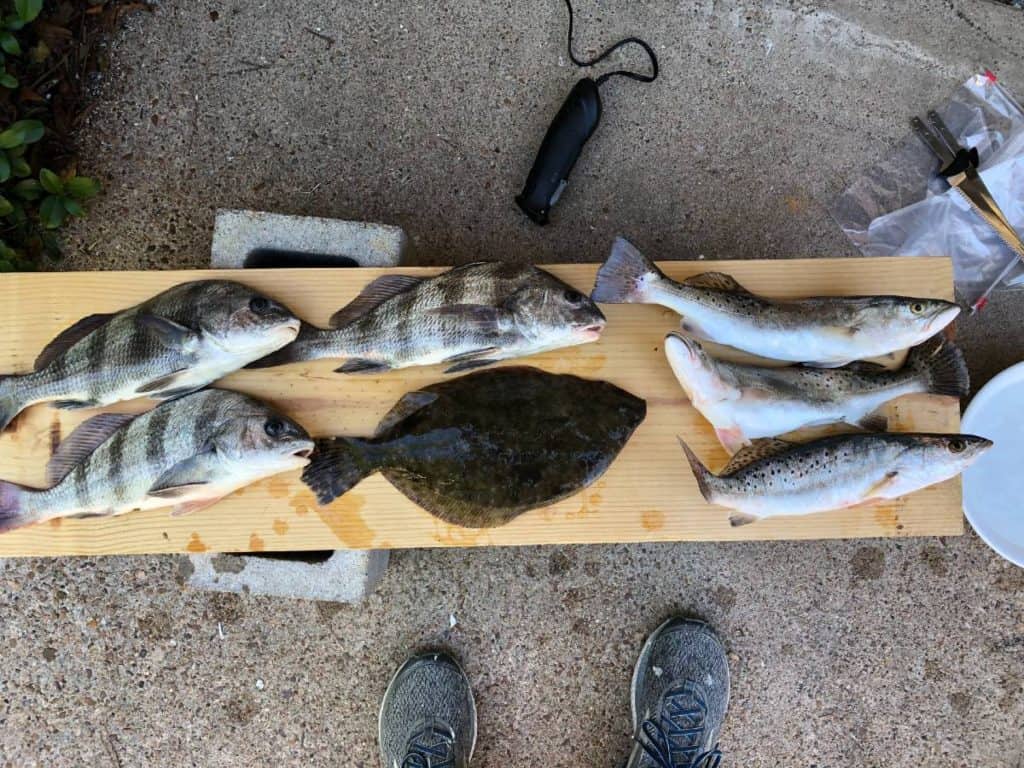
Types of Fishing Jigs
There are three main categories for jig head design (with numerous variations):
- Jig Heads for Live Bait
- Swimbait Jig Heads
- Skirted Bass Fishing Jig Heads
- Bass Swim Jigs
- Football Jigs
- Flipping Jigs
- Punch Jigs
- Finesse Jigs
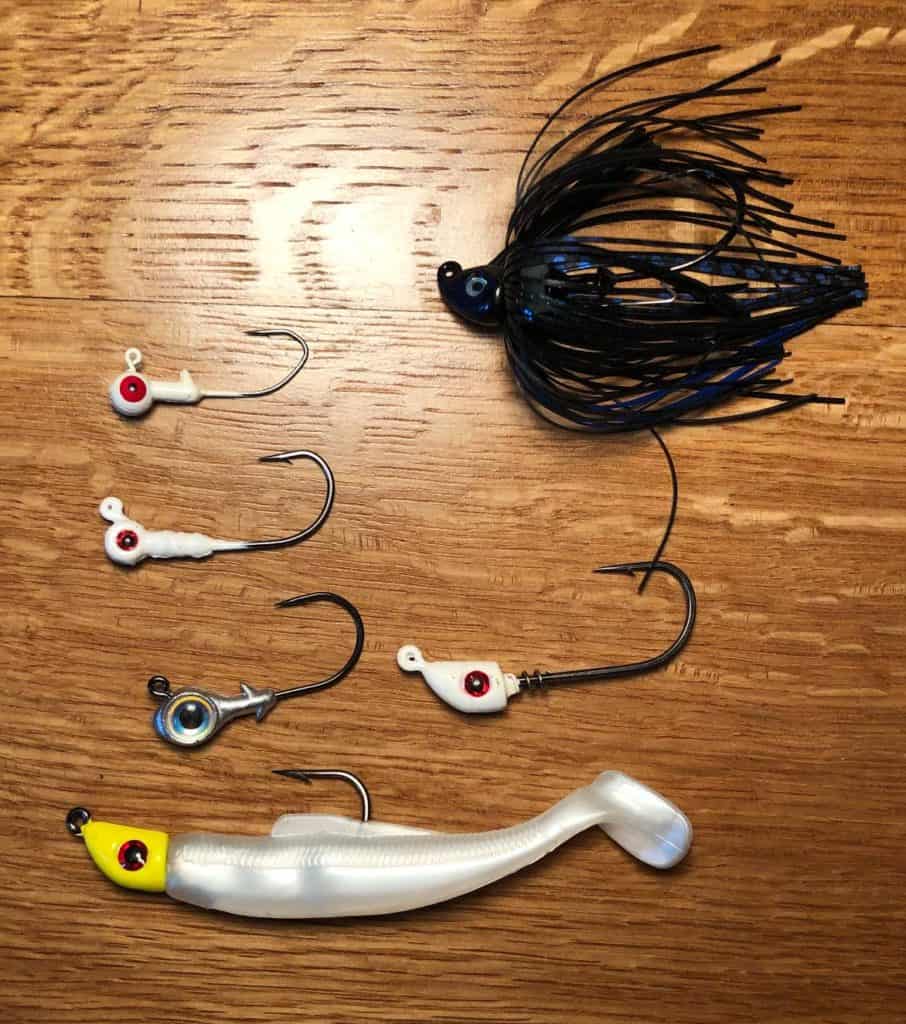
Live Bait Jig Heads
Live bait jig heads are usually combined with nightcrawlers, leeches, or minnows to make an effective rig to target walleye, perch, crappie, bass, and panfish. Live bait jig heads generally have smaller gauge wire for the hooks, smaller hook gaps, and bait keepers better designed to hold live bait.
My favorite freshwater live bait jigs are Neon Moon Eye jigs. They have a perfect bait keeper for nightcrawlers, the right gauge of wire for the hook, and just seem to catch fish.
Swimbait Jig Heads
Swimbait jig heads are designed to work with soft plastic swimbaits. The hook is fed through the body of the plastic swimbait to create a durable, easily fishable rig. The soft plastic swimbaits can be changed if they get torn up by aggressive fish, or you want to try a different bait type.

Medium to large soft plastic swimbait rigs are effective for bass, walleye, redfish, speckled trout, and flounder. Smaller soft plastic jig head rigs are productive for crappie and other panfish species like perch or bluegill.
My favorite soft plastics to pair with swimbait jig heads are Z-Man Diezel MinnowZ paddletails or Gulp swimming mullet.
Swimbait jig heads have various bait keeper mechanisms ranging from a simple hook shape built into the body of the jig head to spring lock mechanisms that bite into the soft plastic bait to keep it in place.
Pro Tip: Take the time to find jig heads with an effective bait keeper mechanism. There is nothing more frustrating than your bait sliding down your hook on every cast.
Skirted Bass Fishing Jig Heads
Bass anglers have adapted the simple weighted jig head into a fit-for-purpose bass catching tool. Bass fishing jig heads intend to mimic crawfish, shad, and/or bluegill and are designed to be fished near structure types that bass frequent.
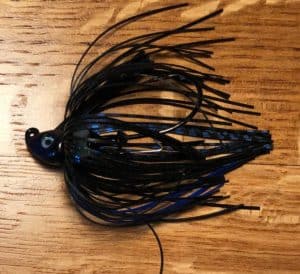
Skirted bass fishing jig heads come in multiple variations, but they all have the same general additional features to effectively target bass. These features include a skirt of rubber or hair that adds movement or ‘interest’ to the bait and a weed guard to help keep the hook from snagging on wood, grass, or other cover.
How to Jig Fish?
While weighted jig heads can be fished anywhere in the water column, they are best used to fish near the bottom. Success jig fishing starts with picking the right jig head type, jig head weight, and rigging your bait properly. Bad jig retrieving technique with proper equipment will still catch fish, whereas great technique can’t always make up for improper equipment selection.
How to Rig a Fishing Jig
Properly baited jigs move more naturally through the water and will induce more strikes. Do yourself a favor and rig your jig right. To properly put most soft plastic baits and live worms on a jig:
- Feed the end of your bait onto the point of the hook
- Continue feeding the bait around the bend of the hook. Keep the hook in the center of the mass of your bait.
- Slip the hook out of your bait when the top of your bait is snug to the head of your jig (and engaged on any bait holder). Your bait should be perfectly straight along the axis of the shank of the hook with the hook point sticking out the top of your bait.
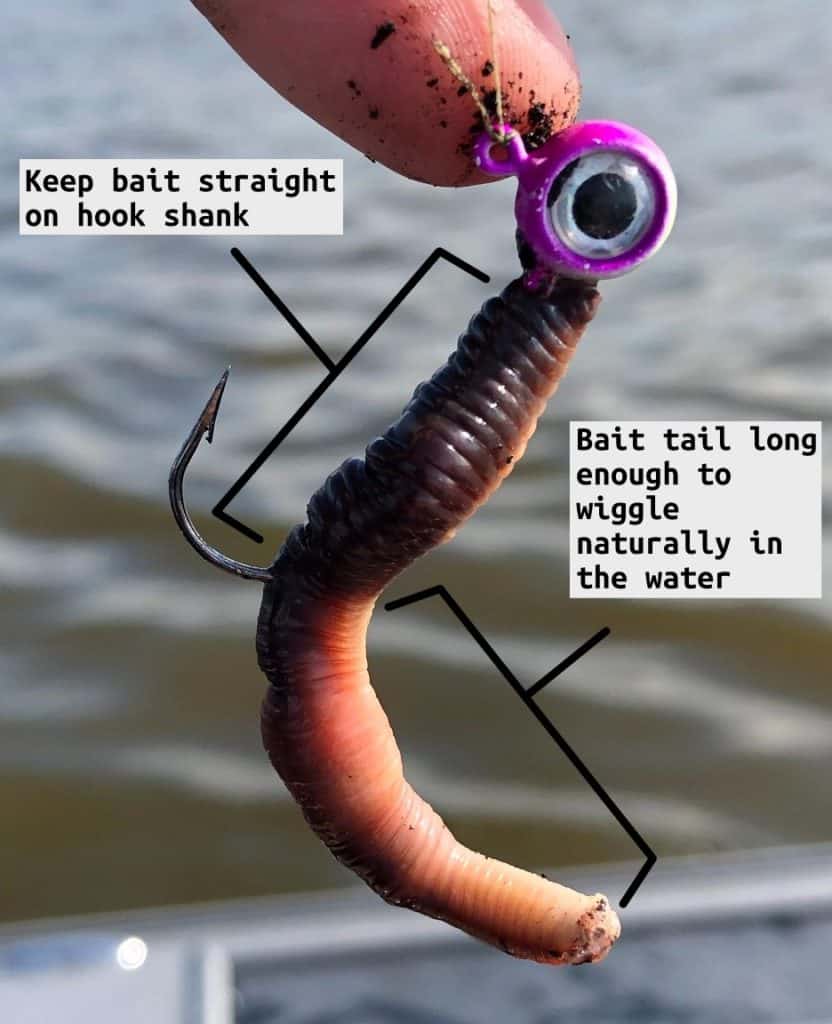
Pro Tip: It’s all about the wiggle, baby. Effective jig baits all seem to have one thing in common…the part of the bait that hangs off the hook wiggles naturally in the water (and induces strikes!). Pick worms or soft plastics long enough to have a ‘tail’ hanging off the end of the hook

For rigging a minnow on a jig head, the most common presentation is to hook the minnow up through the bottom lip and the front of the head so the minnow can wiggle freely behind your jig.
How to Select Jig Head Weight
When picking jig head weight, use the lightest weight jig head that will get you to your target water depth. Lighter weight rigs will fall slower in the water and have a more natural presentation. Heavy jig heads will “bomb it” straight to the bottom and move unnaturally. You may need a heavier jig head if wind or current are pushing your bait around too much.
Pro Tip: Bring a variety of jig head weights. Weather conditions vary trip by trip, adapt your equipment accordingly.
How to Retrieve a Fishing Jig
There are two basic methods to retrieve fishing jigs.
- Straight retrieve. Think dragging the bait along the bottom. Works well with bait with ‘natural’ movement like a paddletail soft plastic. Reel faster if you want to keep the jig higher in the water column.
- Pop and drop or “jigging”. Gently lift your rod tip roughly a foot straight up, then let your bait slowly drop back down to the bottom. Avoid jerky movements. Works fishing vertically or casting out.
Jig Fishing Strategies
Fan cast and cover water until you find the honey hole. Many fish species will stack up on a piece of cover. Cast around until you find the honey. Jig fishing is also great for covering water. Drift a shoreline, channel, point, or dropoff until you find fish.
Grandpa’s Fishing Wisdom: If you ain’t snaggin’, you ain’t catchin’. Fish like the protection of underwater structure. Fish near (or in) the structure to catch more fish. You WILL get snagged, but you WILL catch more fish.
For river fishing, try vertical jigging down a running slough. Depth transitions generally hold fish. Look for changes between 4 and 10 feet water depth.
When to Use a Fishing Jig?
Fishing jigs can be adapted to most fishing conditions. Searchbait? Sure. Fishing your favorite honeyhole? No problem. Bottom fishing? Go for it.
A better question is when NOT to use a fishing jig. Since weighted jig heads are meant to be fished near the bottom, overly snaggy structure can create challenges. Snagging bottom every few casts is ok, snagging every single cast is probably too much. If the bottom structure is too snaggy and using live bait, try swapping to a slip bobber rig for freshwater fishing or a popping cork for inshore fishing.
Additionally, if the fish are feeding higher in the water column, it can be tough to keep a jig at a shallow target depth. Plastic swimbaits can be retrieved quickly to maintain a shallow depth but it may be time to swap to different tackle.
Best Jig Fishing Tackle and Equipment
Certain equipment choices will improve your comfort and chances of success while jig fishing.
Best Rod and Reel for Jig Fishing
The best rod for jig fishing depends on what kind of fish you are targeting. A great all-around jig fishing rod is a 7 foot medium rod with a fast tip.
Jigs can be effectively fished with spinning reels or baitcaster reels. Pick what type of reel you prefer. Generally, people fish swimbait jigs with a casting reel and live bait jig rigs with spinning reels.
Check out our fishing rod articles for solid jig fishing rod options:
- Best Walleye Rods
- Best Ultralight Fishing Rods
- Best Bass Fishing Rods
- Best Flipping & Pitching Rods
- Best Frog Fishing Rods
- Best Inshore Fishing Rods
- Best Saltwater Fishing Rods
- Best Surf Fishing Rods
- Best Pier Fishing Rods
Check out our articles for great reels to pair with these rods:
- Best Baitcasting Reels
- Best Surf Fishing Reels
- Best Saltwater Baitcasting Reels
- Best Saltwater Spinning Reels
Best Line for Jig Fishing
Braided line is best for jig fishing because it has a smaller diameter at the same strength compared to monofilament. Smaller diameter line reduces the effect of wind and current on bait presentation, letting you more effectively present your jig.
I prefer 10 lb braid for freshwater jig fishing and 15-20 lb braid for inshore fishing. An optional leader of 15-20 lb fluorocarbon can help with line-shy fish.
Best Fishing Jigs
Jigs come in all shapes, sizes, and colors. My advice is get jigs with the correct type of bait keeper for your bait of choice and a variety of weights. Bread and butter jig head weights are between ⅛ and ¼ oz but be ready to weight up or weight down depending on weather conditions and target water depth.
My favorite jig for nightcrawlers are Neon Moon Eye jigs. They have a great bait keeper for live worms and the thin gauge on the hooks allow you to pull out of snags instead of losing your jig.
My favorite soft plastics to pair with swimbait jig heads are Z-Man Diezel MinnowZ paddletails or Gulp swimming mullet.
Jig Fishing Frequently Asked Questions
What kind of fish can you catch with a jig?
The most common fish species caught with jigs are largemouth bass, smallmouth bass, bluegill, crappie, catfish, perch, and walleye in freshwater and redfish, speckled trout, flounder, black drum, striped bass, and sheepshead in saltwater.
What is the difference between a jig and a lure?
Lures are usually retrieved horizontally while jigs are retrieved horizontally or vertically. Live bait jig fishing is usually vertical or near vertical fishing, while swimbait jig fishing can be a mix of horizontal and vertical. Lures are hard plastic, soft plastic, or metal artificial baits whereas jigs can be fished with live bait or artificial plastic baits.
What color jig should I use?
Best practice for choosing jig color is to try and match the predominant forage species. If fish are feeding on shad, lean towards a white color. If fish are feeding on crawfish, try to use a natural color like green pumpkin or watermelon. Color choice also depends on water clarity. In clear water, use more muted colors and in murky waters use bolder colors to try and draw attention to your jig.
Conclusion
Jig fishing is a versatile fishing technique that can be adapted for most fish species. Grab a handful of fishing jigs, some soft plastics or nightcrawlers, and get out there and jig fish!
Make sure you have fishing pliers to unhook your fish and the right fillet knife to process your catch!
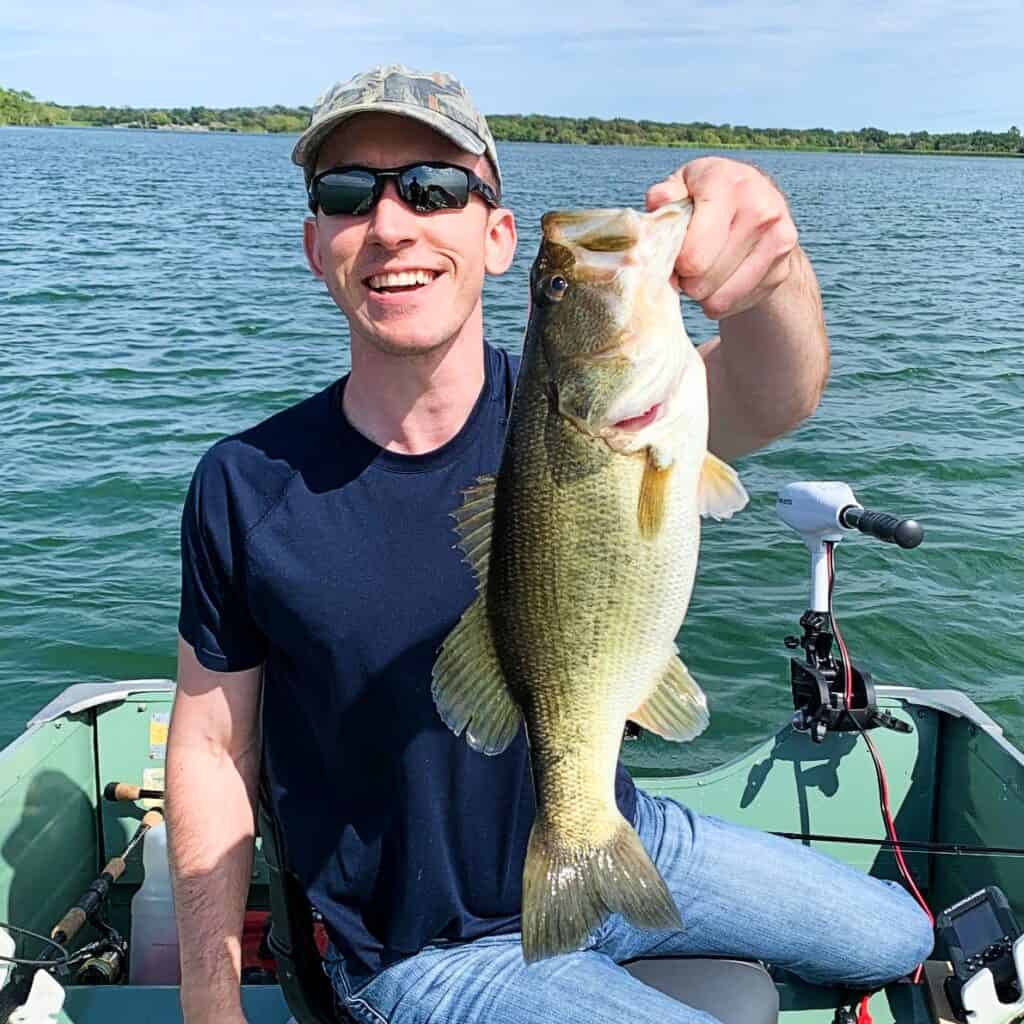
Written By: Andrew Juran
Andrew is a seasoned angler with over 25 years of experience fishing across the United States. He has caught hundreds of fish using various techniques and mentored many in the art of fishing. An advocate for sustainable fishing, Andrew is an active member of the Coastal Conservation Association, an organization committed to marine conservation.
For frequent fishing tips, behind-the-scenes looks, and real-time catches, connect with Andrew on Instagram
